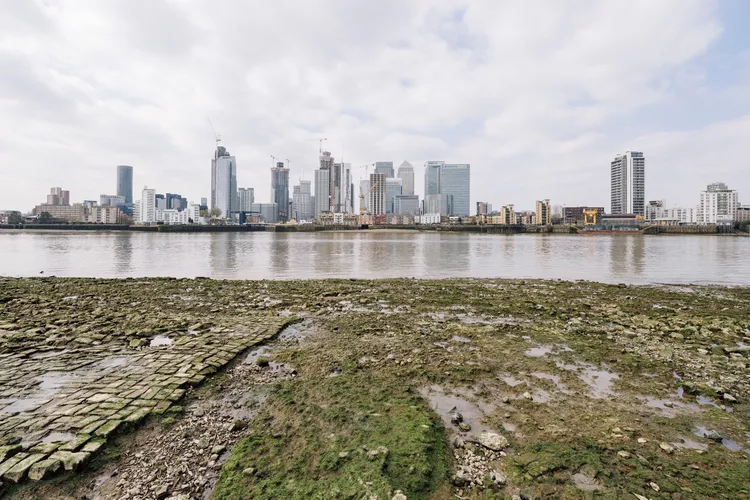Summary of Mudlarking in London
If you’re lucky, you’ll find remnants of life centuries ago. London may not have a beach, but the River Thames runs right through the city, and since it’s a tidal river, the river banks are uncovered every day.
In the 18th and 19th centuries, many poor people in London searched the riverbanks for trinkets that had been dropped into the water and cargo that had fallen off passing boats, and they would sell the treasures they found. Being a mudlark — someone who searched for these items — was a recognized occupation until the early 20th century. However, mudlarking these days is more like beachcombing or treasure hunting for those interested in London’s rich history.
Mudlarking Along the Thames
The Thames is now one of the cleanest metropolitan rivers in the world. However, it was once regarded as London’s trash can. Thames mud is anaerobic (without oxygen) and preserves whatever it consumes, making the 95-mile foreshore (the part of the shore closest to the water) of the tidal Thames one of the richest archaeological sites in Britain.
Moreover, mudlarking is the urban equivalent of beachcombing, where enthusiasts search the foreshore for “treasures” washed up by the river. There are serious mudlarking enthusiasts equipped with specialized gear, and then there are amateur archaeologists interested in uncovering London’s past through the everyday items that emerge.
Mudlarking Rules
As of September 2016, a license is required to search for anything on the foreshore, even if you are just looking without the intent to touch or remove anything. You can apply to the Port of London Authority for a license, where staff can provide clear guidance on what you will be allowed to do and where.
It is very important that any object found on the foreshore that could be of archaeological interest is reported to the Museum of London so everyone can benefit from the find. Through this scheme, mudlarks have helped build an unparalleled record of everyday life on a medieval river.
If you intend to take home what you find, you will need to acquire an export license.
Likely Finds
This is an urban setting, so you are most likely to discover everyday objects that people have discarded, such as pottery, buttons, and tools. It is extremely unlikely that you will stumble upon a bag of diamonds or a sack of gold.
The most common item to find is a clay pipe, which is usually broken and often sits right on the surface. These were smoking pipes sold pre-filled with tobacco. Although they could be reused, they were generally discarded, particularly by dock workers, which explains why they are so prevalent in the river. While that sounds comparable to a modern cigarette butt and not particularly exciting, these pipes date back to the 16th century.
Consequently, remember to take plastic bags for your finds and wash everything in clean water before allowing others to handle them.
Safety Tips for Mudlarking
The most important information you need for mudlarking safely can be found in the daily tide tables. The Thames rises and falls by more than seven meters (about 23 feet) twice daily as the tide comes in and out, and the water is cold.
Always check the exit points because the river rises very quickly and has a remarkably strong current. The steps leading down to the river can be slippery, so climb with care.
Moreover, wash your hands or wear disposable gloves, as the area can be muddy. There is also a risk of contracting Weil’s disease (spread by rat’s urine in the water), and sewage in storm conditions may still be discharged into the river. Infection can typically occur through cuts in the skin or through the eyes, mouth, or nose. Therefore, medical advice should be sought immediately if ill effects arise after visiting the foreshore, especially flu-like symptoms such as fever and body aches. Overall, be careful not to touch your eyes or face before your hands are clean. An anti-bacterial wash can help before you give those hands a thorough scrub.
Wear sturdy footwear, as conditions can be muddy and slippery in many areas. It is also advisable not to go mudlarking alone.
Finally, keep in mind that if you venture onto the foreshore, you do so entirely at your own risk, taking personal responsibility for anyone you are mudlarking with. In addition to the tides and currents mentioned above, potential hazards include raw sewage, broken glass, hypodermic needles, and wash from vessels.
Best Locations for Mudlarking
You can try treasure hunting in some prime locations throughout central London. You can mudlark under the Millennium Bridge outside the Tate Modern on the South Bank or move over to the North Bank near St. Paul’s Cathedral. Outside Gabriel’s Wharf can be an enjoyable place to explore the shore, and the areas around Southwark and Blackfriars bridges on the North Bank are also worth checking out. You could even explore around Canary Wharf if you’re visiting the Museum of London Docklands.





